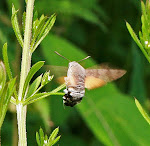
July 26, 2011:
Seeing something move deep in the marginal vegetation of a small pool at Foulshaw, a closer view revealed a Common Hawker emerging from its exuvia, the latter falling back into the water before there was the chance of a photograph. The insect then climbed slowly up a stem of Juncus, its wings folded at first but then gradually spread as it came out into full sunlight. Its thorax and abdomen were already developing a dull grey/brown coloration but its wings and pterostigma were completely colourless and translucent; the characteristic costa was, however, discernable. At first, due to its large size, it seemed that it might be an Emperor but the photos showed otherwise. After a few minutes perching in the sunlight it fluttered away into the nearby trees.
Four stages of emergence shown below (bottom upwards)




Also flying here were Black Darters, Four-spotted Chasers, an Emperor, and many Azure aand Emerald Damselflies.

[Black Darter, male]

[Four-spotted Chaser, male]

[Azure Damselfly, male]

[Emerald Damselflies, pair]
.jpg)




















































